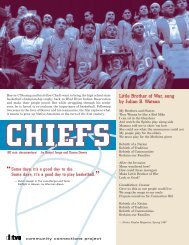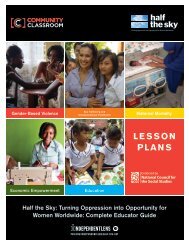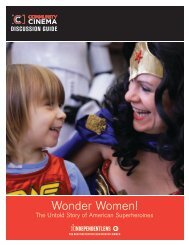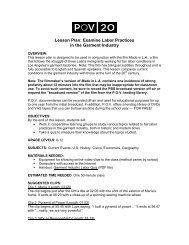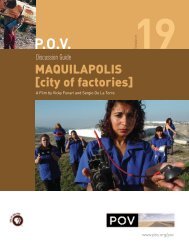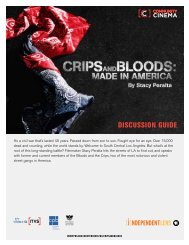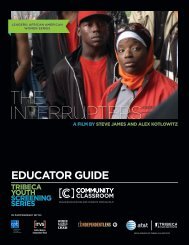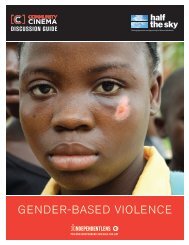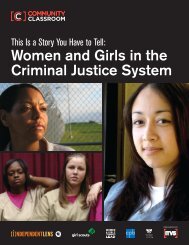economic empowerment - PBS
economic empowerment - PBS
economic empowerment - PBS
- No tags were found...
You also want an ePaper? Increase the reach of your titles
YUMPU automatically turns print PDFs into web optimized ePapers that Google loves.
DISCUSSION GUIDE<strong>economic</strong> <strong>empowerment</strong>Pbs.org/independentlens/half-the-sky
Using This GuideCommunity Cinema is a rare public forum: a space for people to gather who are connectedby a love of stories, and a belief in their power to change the world. This discussion guideis designed as a tool to facilitate dialogue, and deepen understanding of the complexissues in Half the Sky: Turning Oppression into Opportunity for Women Worldwide. It isalso an invitation to not only sit back and enjoy the show – but to step up and take action.This guide is not meant to be a comprehensive primer on a given topic. Rather, it providesimportant context, and raises thought provoking questions to encourage viewers to thinkmore deeply. We provide suggestions for areas to explore in panel discussions, in theclassroom, in communities, and online. We also provide valuable resources, and connectionsto organizations on the ground that are fighting to make a difference.For information about the program, visit www.communitycinema.orgNOTE TO READERS:This discussion guide gives an overview ofthe entire two-hour Half the Sky: TurningOppression into Opportunity for WomenWorldwide film, and then provides specificbackground information and resourcesfor the country segment that deals withEconomic Empowerment in Kenya.Discussion guide // <strong>economic</strong> <strong>empowerment</strong>1
From the FilmmakerAs a filmmaker, the centerpiece ofthe project for me was the documentaryseries. Filmed in ten countries, theseries is inspired by Nick and Sheryl’swork — but also goes beyond the page tofilm new and immediate stories that lendthemselves to the drama that televisiondemands. Our approach was to orchestrate2-week trips to six different countries,following Nick as he reported on an agentof change working to better her own lifeor the lives of women in her community.Joining Nick on each leg of the journeywas a different actress who had experienceadvocating for social issues, butwho was not an expert in the specificissue we were following in that location.Rather, she was there to act as the eyesand ears of the audience, allowing an intimateand honest way into some of thesetough and demanding stories. We had thegood fortune to be joined by Eva Mendesin Sierra Leone, Meg Ryan in Cambodia,Gabrielle Union in Vietnam, Diane Lane inSomaliland, America Ferrera in India, andOlivia Wilde in Kenya.The experience of the shooting was someof the most difficult I have ever experiencedin over twenty years of producingand directing large and complicatedseries. Having directed a ten-hour seriesaboard the USS Nimitz on a six-monthdeployment to Iraq (<strong>PBS</strong>, Carrier), runaway with a traveling circus (<strong>PBS</strong>, Circus),and made a film about toxic waste beingdumped on a Native American community(HBO, Mann v. Ford), I was prepared forand yet still stunned by the conditions inwhich most people in the world live. I wasespecially affected by the experiencesof women living under these conditions.From rough terrain to blistering poverty,the situations were incredibly challengingand the issues were often heartbreaking.For example, children being raped as earlyas two and three years old in post-conflictSierra Leone or the staggering reality oftrafficking and sexual slavery of younggirls in Cambodia. But the women weworked with were some of the most amazing,courageous, and admirable women Ihave ever known. The tears often flowed.Two of the more emotional experiencesoccurred while trying to help the fourteenyear-oldFulamatu seek justice againstthe uncle who raped her and two of herfriends, only to watch the case crumble,and during the harrowing brothel raid inCambodia with the fiery Somaly Mam thatfreed several under-age girls being heldin slave-like conditions where they wereforced to work as prostitutes with 10-30clients per day.Working with Nick and Sheryl was aninvaluable and amazing opportunity as adirector. I was so impressed by Nick inthe field as he tenaciously sought out thestory and by Sheryl’s incredible ability tosee the big picture and address the largeglobal issues. I knew I wanted to honortheir work. We all felt from the start thatit should be an epic production, visuallystunning and visceral, showing the amazingplaces we visited and people we metin all their beauty. We wanted the realityof their world to be accessible and yet,at times, shocking — an edge-of-your-seatadventure with global significance. Wewanted to tell true stories, yet also deepenpeople’s experience and understandingof the issues women and girls face inthe developing world. We also believed,and Nick and Sheryl were deeply committedto showing, that the stories couldand should be uplifting and empowering.Even in the darkest of circumstances, wefound the most startling humanity andconfirmation of the human spirit’s resilience.People who engage with all of ourcontent — on the multiple platforms available— will be angry, motivated, inspired,and most important, feel connected to thesubjects and themes. We wanted to createa unique experience that goes beyond“issue” filmmaking to simply tell incrediblestories about the capacity of humanbeings to persevere against all odds andthe restorative power of opportunity inparts of the world that are not “over-there,”but a small leap from our own backyard.Discussion guide // <strong>economic</strong> <strong>empowerment</strong>3
The FilmEpisode TwoEpisode Two continues our journey to the hot spots of gender oppression around the world and highlightsthe courageous work of some of the extraordinary women and men who are taking a stand in the faceof incredible odds. This episode focuses our attention on the role of women in their families and theircommunities — examining the fundamental obstacles that hinder their potential, and charting the ripple effectthat results when that potential is harnessed.Veteran journalist and Half the Sky: TurningOppression into Opportunity for WomenWorldwide co-author Nicholas Kristof isonce again accompanied by a three celebratedAmerican actresses who offer freshand personal perspective on the issues ineach country. Kristof travels to Somalilandwith Diana Lane to examine maternalmortality and female genital mutilation,to India with America Ferrera to exploreintergenerational prostitution, and withOlivia Wilde to Kenya, where the transformativepower of <strong>economic</strong> <strong>empowerment</strong>is changing women’s lives and is layingthe groundwork for the next generation. Inthe process, the film considers the centralrole of women in the health and stability oftheir families and communities and establishestheir critical role in the global effortsto eradicate poverty and achieve peace.Featuring on-camera commentary fromSheryl WuDunn and some of the world’smost respected and outspoken advocatesfor gender equality — including MelanneVerveer, Zainab Salbi, and DesmondTutu − Episode Two underscores the fundamentalobstacles to women’s progressand prosperity and celebrates women’sboundless capacity to better our world.Maternal MortalityThe episode begins in Somaliland — anunrecognized country, populated mainlyby nomads, where the average womantoday has a 1-in-12 chance of dying inchildbirth. Joined by actress Diane Lane,Kristof reconnects with Edna Adan, founderof the Edna Adan Maternity Hospitalin Hargeisa. A spry 70-something womanoften and rightly described as a “force ofnature,” Adam is almost single-handedlyrevolutionizing the experience of childbirthin her country — providing medical care towomen who would otherwise have none,training midwives, and fighting tirelesslyagainst female genital mutilation — a traditionalpractice still common in much ofAfrica (and elsewhere), which severelycompromises a woman’s ability to delivera child. In Somaliland, the challengeswomen face in the developing world arestarkly apparent: Poverty and traditionconspire to undermine a woman’s health,directly threatening her life, and having alasting impact on her children’s survivaland ability to thrive.Intergenerational ProstitutionAs WuDunn and our cast of gender equalityadvocates argues, tradition is, in manyways, the greater evil. In too many placesin the world, tradition still is used to marginalizewomen, to keep them down andin their place. This vicious cycle repeatsitself generation after generation, damagingand ending lives and undermining theability of thousands of women improvetheir quality of life and live their fullpotential. The key — as Kristof and actressAmerica Ferrera discover in India — isintervention by someone from the inside:someone like Urmi Basu. A social workerand an educated, middle-class Bengali,Basu has dedicated her life to stoppingthe cycle of intergenerational prostitutionin India, where 90 percent of girls bornto sex workers follow in their mothers’footsteps. What she is up against is neatlyillustrated by one of the young girls inher care, Monisha, who is on the brink ofbeing wrenched out of school and likelysold to a brothel by her own family — afamily that belongs to a sub-caste of sexworkers. What keeps Basu going is girlslike Sushmita — and more to the point,women like Sushmita’s mother, Shoma,who has lived the utter brutality and desolationof prostitution every day of her lifeand desperately wants a different fate forher daughter. Shoma’s hope for her childis the seed of real and lasting change.Economic EmpowermentWhen women have equal control overtheir finances and the financial decisionmakingon the personal, community,and national levels, everyone benefits.WuDunn and the many contributors wholent their voices and considerable expertiseto Half the Sky: Turning Oppressioninto Opportunity for Women Worldwideall stress that putting money in the handsof a poor woman changes everything.During their visit to Kenya, Kristof andOlivia Wilde witness the impact of the<strong>economic</strong> <strong>empowerment</strong> of women firsthand.In this episode’s final segment,they explore the impact and challenges ofmicrofinance and the ways is transformingthe lives of women and those aroundthem. We begin with Jane Ngoiri, a formersex worker-turned-dressmaker who is nowable to send her four children to school,where they are each at the top of theirclass, and end with Rebecca Lolosoli, aSamburu woman who built a safe havenfor women on the slender thread of a jewelry-makingbusiness. Kristof and Wildesee for themselves the dramatic andtangible transformation that can be set inmotion by a woman with a little money ofher own and a system of support to helpher make the best use of her financial andpersonal resources. Replicate the experimentseveral million times, and the worldwill be an entirely different place.The episode — and the film — ends withan urgent call to action, an invitation tothe viewer to take up the central moralchallenge of our time, and to join a movementthat will tap the immense potentialof women to create a more peaceful andmore prosperous world for us all.Discussion guide // <strong>economic</strong> <strong>empowerment</strong>6
“We want to choose our husbands. Wewant to own the land. We want to go toschool. We don’t want to be cut anymore.We also want to make decisions. We wantto participate in politics, to be leaders. Wewant to be equal.”–Rebecca Lolosoli, Founder of UmojaIndividuals Featured in EconomicEmpowerment in KenyaNicholas KristofJournalist; Co-Author of Half the Sky:Turning Oppression into Opportunityfor Women WorldwideSheryl WuDunnJournalist; Co-Author of Half the Sky:Turning Oppression into Opportunityfor Women WorldwideOlivia WildeActress; ActivistIngrid MunroFounder of Jamii BoraJane NgoiriIndependent businesswoman;Member of Jamii BoraRebecca LolosoliCo-founder and matriarch of Umoja,a women-only villageKabeh S. SumboOwner of Passama Agriculture TradingCorporation in LiberiaSources:»»www.bbc.co.uk/news/world-africa-18574734»»ictj.org/publication/institutional-reform-newconstitution-kenya»»www.odi.org.uk/resources/details.asp?id=1522&title=crisis-kenya-land-displacement»»www.afrol.com/Categories/Women/profiles/kenya_women.htm»»kenvironews.wordpress.com/2008/09/08/a-snapshot-of-the-situation-of-women%E2%80%99s-rights-in-kenyaBackground InformationKenya Past and PresentKenya is a relatively stable African country with a truly multicultural population, whoseethnic diversity has produced a vibrant culture. It is also a country that spent 80 yearsfighting for freedom from colonial rule, only to face four decades of political corruptionthat has undermined its <strong>economic</strong> and civic development and contributed to the dis<strong>empowerment</strong>of millions of women.The colonial period in Kenya was a time of vicious political and cultural oppression and<strong>economic</strong> exploitation for the indigenous communities who had lived in that region forcenturies. In 1894, Britain declared protectorate over Kenya, and the new state’s boundarieswere drawn without the consultation of Kenya’s people. This act arbitrarily broughttogether over 40 previously independent communities into one territorial entity. The ongoingcivil unrest that Kenya faces finds its roots in the painful legacy of violence and ethnictension from the country’s colonial era.After achieving independence from Britain in 1963, Kenya’s leader, Jomo Kenyatta,consolidated the political parties under the Kenya African National Union (KANU) party,and by 1969, had banned all other political parties. He was succeeded in 1978 byDaniel arap Moi, who maintained one-party rule under KANU and remained in powerfor 24 years. In the early 1990s, violent unrest and international pressure led to therestoration of multiparty politics, but it took another decade before opposition candidateMwai Kibaki ended nearly 40 years of KANU-party rule with his landslide victory in2002’s general election.Despite President Kibaki’s pledge to tackle corruption, mismanagement of internationalaid has been a continuing issue, with some donors estimating that up to one billion dollarswas lost between 2002 and 2005 alone. In addition to high-level corruption and graft,Kenyans also face crippling daily challenges including high unemployment, widespreadcrime, reoccurring droughts, and extreme poverty, with most Kenyans living on less thanone dollar a day.For Kenyan women, poverty and pervasive traditionalism are the two major obstacles toobtaining equal rights. Although government policy, legislation, and the media favor women’srights, the traditional view of women’s low status has proven difficult to overcome.Violence against women is a serious problem, with many traditional cultures permittingand even encouraging men to physically discipline their wives. The practice of femalegenital mutilation (FGM) is prevalent, with about 50 percent of Kenyan women havingsuffered FGM. Rape is also widespread despite legal prohibitions, and there is substantialevidence that incidence of child rape is growing. Underlying all of these violations ofwomen’s rights is a deeply entrenched <strong>economic</strong> discrimination linked to cultural traditionsand customary laws that deny women the right to make decisions about their ownresources and to inherit and own land.Recent political improvements — including the new constitution adopted in 2010 thatdelegates more power to local governments and gives Kenyans a bill of rights — haveinspired cautious optimism for many Kenyans. These changes are especially importantfor women who hope to benefit from policies that seek to end gender discrimination andsupport women’s leadership and participation, such as a quota guaranteeing a minimumof 47 women members of Parliament in the National Assembly.Discussion guide // <strong>economic</strong> <strong>empowerment</strong>7
Background InformationSavings for Women That SavesWomen: Ingrid Munro and theJamii Bora Microfinance ProgramJamii Bora is the largest and fastest-growing microfinance institution in Kenya. In 1999,Ingrid Munro, a retired civil servant from the Swedish Bureau of Housing Research andformer head of the African Housing Fund (AHF), founded Jamii Bora with 50 Kenyanwomen whose only income at the time was made by begging in the street. Ingrid agreedto loan them twice as much as they agreed to save so they could invest in starting abusiness and acquiring resources that would empower them to generate income andimprove the quality of life for themselves and their families. The project was a success,and since then Jamii Bora, which means “good families” in Swahili, has grown to almosttwo hundred thousand members.Jamii Bora’s lending is concentrated on the needs of its members, and the majority of theloans are very small. The average loan size is around $90 and almost 80 percent of theloans are less than 10,000 Kenyan shillings (about $119). Many of them are starter loansthat could be as small as a few hundred shillings.The first loans usually have a dramatic effect on the lives of Jamii Bora’s members. Asillustrated by the organization, a potato street vendor who has saved KSh 400 can borrowKSh 800 and buy twice as many potatoes from a wholesale vendor. She earns dramaticallymore for every potato she sells because she bought the potatoes at wholesaleprice and is still selling them at the same price as before. Normally, after three to fourweeks she will come back for her next loan, now having saved KSh 800 and being ableto borrow KSh 1,600 to buy two sacks of potatoes. Jamii Bora has many members whostarted with loans of less than KSh 1,000 and who in one to two years grew into bigbusinesses.Where most microfinance programs in Africa have failed, Jamii Bora has succeeded. Thisis due in part to its microsavings model, which requires every member to participate inthe savings program for at least six weeks before receiving a loan and ensures that loansare never more than twice the amount of the borrower’s savings. Its facilitators also recognizethat it is not enough to just lend money—as Ingrid Munro says in the film, “Startingmicrofinance with the poorest of the poor is not something you should do if you’re notready to fight problems every day.… To get people out of poverty, you need to deal withevery aspect of their life.”Sources:»»www.halftheskymovement.org»»www.jamiibora.org»»www.ashoka.org/fellow/ingrid-munro»»aitecafrica.com/user/view/Ingrid+MunroJane Ngoiri, a Jamii Bora member, is an example of the value of microfinance programsand how they can empower individual women and help break the cycle of poverty fortheir families for generations to come. Jane is a 38-year-old single mom who grew upin the slums of Nairobi, Kenya, and dropped out of school after the eighth grade. Shemarried at age 18, but when she was pregnant with her second child, her husband informallytook a second wife. She soon found herself with small children, no home, and nomoney. Jane became a commercial sex worker for five years in order to survive. In 1999,she joined Jamii Bora, where she was pushed to save for the future. She learned to sew,left prostitution, and used her savings and a small loan to buy a sewing machine so shecould repurpose secondhand dresses into children’s clothes. Her business was a successand with the profits she bought a small home in a safe suburb and continues toprovide for her children’s future. Jane still struggles with the costs of raising a family andhas recently discovered that she is HIV positive, but now she has marketable skills, anestablished business, and a positive reputation that she can fall back on in times of crisis.Discussion guide // <strong>economic</strong> <strong>empowerment</strong>8
Background InformationUmoja: Rebecca Lolosoliand Women’s UnitySamburu women are among the most marginalized groups in Kenya.The Samburu are a distinct ethnic group in northern Kenya with a culture and languageclosely related to the Masai. The area where the Samburu live is about thirteen thousandsquare miles, with a population of one hundred and sixty-seven thousand. The communitylives in manyattas, traditional villages comprised of several huts made of palm leaves,wood, and roofs of cow dung. Development has been slow to reach this area and educationis often not easily accessible. Women have a low status in the community and arethe last to receive the few resources available.Within this context, many women are subject to severe mistreatment by their husbandsand the men in their families and some choose to leave in order to be spared the abuse,despite the fact that women have few opportunities to provide for themselves and theirchildren independently. In addition to the risk of domestic violence, Samburu women arealso vulnerable to violence from foreigners who visit their region. During the 1980s and1990s, fourteen hundred women are believed to have been raped by British soldiers fromtraining bases in the area.Rebecca Lolosoli grew up in the Samburu tribe and attended primary school and thennursing school before dropping out early due to a lack of money for school fees. Shemarried at the age of 18 and then started her own business selling goods. When shelearned about the women who had been raped by British soldiers, she began to speakup in their defense. In retaliation, neighborhood men beat her, and when her husband didnot protest the beatings, she left him.In 1990 Lolosoli, along with 15 other women who were also survivors of violence, establishedUmoja, a women-only village. Umoja means “unity” in Swahili and this village provideswomen a place where they can live with their children in an atmosphere of collectivesecurity and cooperation. To sustain themselves, the women sell beadwork and openup their village to tourists.Sources for Umoja: Rebecca Lolosoli andWomen’s Unity»»www.umojawomen.org/history.htm»»www.halftheskymovement.org»»www.vitalvoices.org/node/1115»»www.thedailybeast.com/articles/2011/03/08/rebecca-lolosoli-the-beadmakers-refuge-forwomen.htmlLolosoli and the women of Umoja have dedicated themselves to informing women abouttheir rights and their health (including reproductive health, prenatal care, and protectionagainst female genital mutilation) and have helped more women start their own incomegeneratingprograms. They have also cooperated with a UK human rights lawyer to havethe rape cases against the British soldiers investigated and brought to trial. These investigationsare ongoing. Their success has encouraged more women to join them but it hasalso drawn abuse and intimidation from men in the surrounding communities who arejealous of and threatened by the Umoja community.Despite these challenges, Umoja continues to grow. Lolosoli has been repeatedly electedas chairperson of the village and is also chair of her local chapter of Maendeleo YaWanawake Organization (MYWO), a nonprofit, voluntary group working to improve thelives of women and youth in Kenya. She plans to run for local office and will be the firstSamburu woman ever to do so.Discussion guide // <strong>economic</strong> <strong>empowerment</strong>9
Economic EmpowermentWomen play a vital role in the <strong>economic</strong> prosperity of their families, communities, andcountries, yet in every part of the world, women work longer hours than men, are paidless for their work, are at a higher risk of unemployment, and are far more likely to live inpoverty.“If we empower women we empowersociety. There is a direct correlation.We are not just changing a life, we arechanging a community.”–Roshaneh Zafar, Founder and managingdirector of the Kashf FoundationFast Facts• Approximately 70 percent of the world’s poor are women and girls.• Women earn less than 10 percent of the world’s wages, but do more than two-thirds ofthe world’s work.• Women reinvest 90 percent of their income into their families, while men invest only 30 to40 percent. In Brazil, when income is in the hands of the mother, the survival probabilityof a child increases by about 20 percent.• According to a report by the World Economic Forum, the United States ranks 19th in theworld in the area of <strong>economic</strong> participation for women and 46th in the area of <strong>economic</strong>opportunity.• It is estimated that if women’s paid employment rates were increased to the same levelas men’s, the U.S. gross domestic product (GDP) would be 9 percent higher; the euroarea’s would be 13 percent higher, and Japan’s would be 16 percent higher.• Where women are better represented in national government, they also tend to be betterrepresented in top administrative positions as well as in the labor force at large.• Women remain severely underrepresented in occupations that are traditionally maledominated(e.g., formal professions, skilled labor, civil service positions) even thoughthese jobs pay 20 to 30 percent more than traditionally female jobs (e.g., caretaking,textile and garment work, retail, food preparation).• Studies show that when women have secure rights to their land, their families’ nutritionand health improve. In addition, women may be less likely to be victims of domesticviolence and children are more likely to receive an education and stay in school longer.• In sub-Saharan Africa, women own less than 2 percent of the land, but produce morethan 90 percent of the food.• In developing countries, women and girls are most often responsible for household andcommunity water management and travel great distances in search of water, which limitstheir time for other activities, including doing income-generating work.• South African women collectively walk the equivalent of a trip to the moon (384,400kilometers or 238,855 miles) and back 16 times a day to supply their householdswith water.• Economically empowered women tend to have fewer children.• In one out of three households around the world, women are the sole breadwinners.• Each additional year in school raises a woman’s earnings by about 15 percent.Discussion guide // <strong>economic</strong> <strong>empowerment</strong>11
“A community can never fly, a family cannever fly, if one of its wings is broken.”–Zainab Salbi, Founder of Women forWomen International University HospitalBenefits of EconomicEmpowermentA growing body of research shows that enhancing women’s <strong>economic</strong> opportunitiesplays a critical role in reducing poverty as well as gender-based discrimination and violence,improving women and girls’ access to education and civic participation, and raisingthe quality of life for future generations. When women are in charge of their financial destinies,income, and capital – such as land and livestock – they gain more control over theirown lives and personal security and as a result have greater access to decision-makingand leadership roles in their homes and communities. Women are also consistently morelikely to reinvest profits back into their families, which — in addition to improving their ownchildren’s nutrition, health, and education – contributes to the <strong>economic</strong> growth and securityof their communities and countries.Barriers to Women’s Economic Security• Financial dependence. Women who are denied the opportunity to earn and control theirown income and participate in important decisions regarding their personal finances andthe <strong>economic</strong> security of their families are at greater risk of poverty and domestic violenceand are more vulnerable to reproductive and maternal health challenges.• Limited participation in the workforce. Worldwide, women are more likely to be relegatedto work in the informal sector (such as domestic services and child care) wherewages are unregulated and workers lack basic rights and job security. Women who workin the formal sector are more likely to experience discrimination and occupy fewer leadershipand decision-making positions than their male co-workers.• Unequal pay. Despite doing the majority of the world’s work, women earn on averagebetween 10 and 30 percent less than men. According to a 2009 report by the U.S.Census Bureau, women who work full-time, year-round earn on average 23 percent lessthan men who work comparable hours.• Child care. Traditional gender roles limit women’s ability to participate equally with menat work and also limit men’s responsibility for child care and unpaid work duties.• Access to land. Women’s ability to own and inherit land is limited or denied in manycountries as a result of social and cultural traditions, legal restrictions, and the lack ofinformation and education available to women.Discussion guide // <strong>economic</strong> <strong>empowerment</strong>12
“The mothers are the key to gettingtheir family out of poverty.”–Ingrid Munro, Jamii BoraWhat is Needed?Women have an essential role to play in the global campaign to eradicate poverty, butprogress on women’s <strong>economic</strong> <strong>empowerment</strong> continues to be slow and uneven. Limitedaccess to land and property, housing, credit, technology, and markets has underminedwomen’s livelihoods and restricted their ability to benefit from the <strong>economic</strong> growth theyhelp to generate. The following strategies have been identified as critical to ensuringwomen’s <strong>economic</strong> <strong>empowerment</strong>:• Promote equal opportunities for women in employment and tackle gender-baseddiscrimination in all areas of the public sphere.• Support professional development programs that target women and girls and provideleadership training and mentorship.• Provide resources and enact policies that support women who are juggling paid workand family responsibilities and provide support for men, such as paternity leave, so theycan take a greater role in child care and domestic tasks.• Increase the number of women entrepreneurs and the size of their businesses by givingthem greater access to financial services such as microfinancing, training, technicalassistance, and networking to share best practices.• Improve women’s access to a range of financial services — including savings, credit, andinsurance – as well as the right to own and inherit land.• Increase women’s leadership and participation in <strong>economic</strong> decision-making bodies atevery level.Discussion guide // <strong>economic</strong> <strong>empowerment</strong> 13
Topics and Issues Relevantto the Film.A screening of the EconomicEmpowerment in Kenya segmentcan be used to spark interest in anyof the following topics and inspireboth individual and communityaction. In planning a screening, considerfinding speakers, panelists, ordiscussion leaders who have expertisein one or more of the followingareas:Women’s <strong>empowerment</strong>Women’s <strong>economic</strong> equalityWomen and girls’ leadershipGender issuesHuman rightsGlobal povertyInternational developmentMicrofinance and microsavingsprogramsThinking More Deeply1. What insights did the Economic Empowerment in Kenya segment give you about the<strong>economic</strong> status of women and girls around the world? What information surprised youthe most?2. What role has the issue of <strong>economic</strong> <strong>empowerment</strong> played in your life? Were there different<strong>economic</strong> expectations for girls and boys in your community or family? Were youexpected to be financially independent when you grew up? How did your experiencecompare to that of the women in the film?3. Why is <strong>economic</strong> <strong>empowerment</strong> an important issue? Discuss how it affects children, families,communities, and nations. How can women’s <strong>economic</strong> independence break the cycle ofpoverty?4. When we read about problems in communities, our minds tend to go immediately to aidprograms and aid organizations, but what about business as a solution? What are the benefitsand pitfalls of social entrepreneurship in comparison to traditional aid?5. In the film, Nicholas Kristof explains that microfinance programs have not been as successfulin Africa as they have in Southeast Asia. Why do you think that is? What challengesdo women in African countries face that are unique to their regions?6. Ingrid Munro suggests that one of the reasons microfinance programs are seen as beingunsuccessful is that researchers are only examining the impact of programs on the mothers’quality of life. She recommends that, instead of the mothers, researchers should befocusing on their children, who are the best indicators of a program’s success. Why isthat?7. Ingrid says that in order to “get people out of poverty you need to deal with every aspectof their life.” What does she mean by this? Do you agree with this statement? Is thisholistic approach to <strong>economic</strong> <strong>empowerment</strong> sustainable? Why or why not?8. While walking through the market, the women from Jamii Bora tell Kristof and OliviaWilde that “the men buy the sodas, the women buy the milk.” Why is this exchange sosignificant? What does it reveal about the financial dynamics of Kenyan families?9. Rebecca Lolosoli says, “We love our men, but our men are not lovers,” and later stressesthe need to educate and empower boys as well as girls in order to improve quality of lifefor the next generation. What role do men have to play in women’s <strong>economic</strong> <strong>empowerment</strong>?How does empowering women improve quality of life for men?10. In what ways would the impact of Umoja’s work be different if the women were integratedback into the Samburu community? Is it necessary for them to remain separate in orderfor them to have <strong>economic</strong> independence? What impact do you think the Umoja projectwill have on the next generation?11. Kabeh S. Sumbo, the oil entrepreneur from Liberia, says that her <strong>economic</strong> <strong>empowerment</strong>has changed her life, “But not only my life, the life of my children and my colleaguesat the market.” What ripple effect has her success had on her community?12. Helene Gayle, president and CEO of CARE USA, says, “Just a small loan can start arevolution.” What does she mean by this? How does <strong>economic</strong> <strong>empowerment</strong> impactwomen’s progress in other areas, such as education, reproductive health, gender-basedviolence, and women’s leadership?Discussion guide // <strong>economic</strong> <strong>empowerment</strong>14
Suggestions for ActionTogether with other audience members, brainstorm actions that you might take as an individual and thatpeople might do as a group. Here are some ideas to get you started:1. Join the global movement for women’s <strong>economic</strong><strong>empowerment</strong>. Visit the Half The Sky: Turning Oppression IntoOpportunity For Women Worldwide movement website (www.halftheskymovement.org) to learn more about the issue and findout how to host a screening with your friends, family, community,or organization and facilitate a discussion of the film and thebest-selling book that inspired it.2. Kick-start a conversation. Women’s World Banking (WWB) is aglobal network of 39 financial organizations from 27 countries andthe only microfinance network with an explicit focus on women.Visit the WWB website to learn how you can host an event tokick-start the conversation about <strong>economic</strong> <strong>empowerment</strong> and findout how your organization or company can work with WWB tomake a difference. The website provides complete details for planningthe event and a multimedia tool kit to help bring the issue tolife for your community.Women’s World Banking (WWB): www.swwb.orgThe “Host Your Own WWB Event” section of the WWB website:www.swwb.org/content/host-your-own-wwb-event3. Connect with communities and share your skills. Kiva is agrassroots nonprofit organization with a mission to connectpeople through lending to alleviate poverty. Kiva relies heavilyon their team of committed volunteers and offers a range ofopportunities to get involved, including the Kiva TranslationProgram and the Kiva Fellows Program, which has offered overfour hundred individuals an opportunity to put their skills to workin support of global microfinance. Visit Kiva’s website for moreinformation: www.kiva.org4. Find out more about how women’s <strong>economic</strong> <strong>empowerment</strong>can help end global poverty. In September 2000, the UnitedNations (UN) signed the Millennium Development Goals (MDGs)with the aim of halving the number of people living in poverty,reducing child mortality, fighting disease, and improving socialand <strong>economic</strong> conditions in the world’s poorest countries by2015. Learn more about the Millennium Campaign’s focus onwomen and find out how you can help:United Nations Millennium Development Goals:www.un.org/millenniumgoalsEnd Poverty 2015: www.endpoverty2015.orgThe “Get Involved” section of the UN MDGs website:www.un.org/millenniumgoals/getinvolved.shtmlThe “Millennium Development Goals” section of the UN Womenwebsite: www.unifem.org/gender_issues/millennium_development_goalsMDG Monitor: www.mdgmonitor.org5. Help break the cycle of poverty by ensuring that women canown their land. Studies show that when women have securerights to their land, their families’ nutrition and health improve,they may be less likely to be victims of domestic violence, andtheir children are more likely to receive an education and stayin school longer. Landesa is an organization working to makeland ownership accessible to women around the world. Talk toyour elected representative about why you care about <strong>economic</strong><strong>empowerment</strong> worldwide. You can request an information packetfrom Landesa by email: info@landesa.org, and the following websitecan help you contact your local elected officials:www.usa.gov/Contact/Elected.shtml6. Become a volunteer, mentor, or tutor. Help supportorganizations that empower women and share yourleadership and skills with the next generation. Volunteer inan area chapter of CARE and connect with the Girl Scouts ofthe USA to learn more about girls’ <strong>economic</strong> <strong>empowerment</strong>and mentoring opportunities. CARE and Girl Scouts of theUSA are among the many organizations and campaignsthat have partnered with the Women & Girls Lead initiativeof the Independent Television Service (ITVS) to improvethe lives of millions of people around the world. See www.womenandgirlslead.org for more details.The “CARE in Your Community” section of the CAREwebsite: www.care.org/getinvolved/regional/index.aspThe “Volunteering” section of the Girl Scouts of the USA website:www.girlscouts.org/for_adults/volunteeringDiscussion guide // <strong>economic</strong> <strong>empowerment</strong>15
Resourceswww.halftheskymovement.org –This is the official website for theHalf The Sky: Turning Oppression Into Opportunity For WomenWorldwide movement, as well as for the book and film of thesame name.www.careinternational.org – CARE International is an organizationthat is fighting poverty and injustice in more than 70 countriesaround the world and helping 65 million people each year findroutes out of poverty.www.swwb.org – Women’s World Banking (WWB) is a globalnetwork of 39 financial organizations from 27 countries and theonly microfinance network with an explicit focus on women.www.cedpa.org – The Centre for Development and PopulationActivities (CEDPA) works through local partnerships to givewomen tools to improve their lives, families, and communities.CEDPA’s programs increase educational opportunities for girls,ensure access to lifesaving reproductive health and HIV/AIDSinformation and services, and strengthen good governance andwomen’s leadership in their nations.www.girlsinc.org – Girls Inc. inspires all girls to be strong, smart,and bold through life-changing programs and experiences thathelp girls navigate gender-related, <strong>economic</strong>, and social barriers.www.landesa.org/women-and-land – The Landesa Center forWomen’s Land Rights recognizes that the lack of secure landrights is a root cause of global poverty. Their land law and policyexperts help poor countries develop and implement land laws,policies, and programs that provide ladders out of poverty for theircitizens and promote long-term <strong>economic</strong> growth.www.kiva.org – Kiva is a grassroots nonprofit organization with amission to connect people through lending to alleviate poverty.us.camfed.org – The Campaign for Female Education (Camfed)fights poverty and HIV/AIDS in Africa by educating girls andempowering women to become leaders of change.www.girleffect.org – The Girl Effect is a collective movement to lift50 million women and girls out of poverty by 2030 through theeducation and <strong>empowerment</strong> of girls.www.unicef.org – The United Nations Children’s Fund (UNICEF) ismandated by the United Nations General Assembly to advocatefor the protection of children’s rights, to help meet children’sbasic needs, and to expand their opportunities to reach their fullpotential.www.womenforwomen.org – Women for Women Internationalprovides women survivors of war, civil strife, and other conflictswith the tools and resources to move from crisis and povertyto stability and self-sufficiency, thereby promoting viable civilsocieties.www.worldvision.org – Recognizing women and girls as criticalpartners in development, the Christian humanitarian organizationWorld Vision works to equip, protect, and advocate for women innearly one hundred countries.A Message from New VideoNew Video, a Cinedigm company, is a leading entertainmentdistributor and the largest aggregator of independent digitalcontent worldwide. New Video’s Docurama Films is proud tooffer Half the Sky: Turning Oppression into Opportunity forWomen Worldwide as part of its roster of acclaimed, awardwinningdocumentaries. Here are ways in which grassrootsorganizers and home video consumers might utilize the DVD tospread the message of the film and benefit their organizations:• Affiliate Program: New Video offers a free Affiliate Program thatallows organizations or individuals to earn a 10 percent referral feeoff every DVD purchased through a unique tracking link on theirwebsites, social media properties, and signatures. (www.newvideo.com/about/affiliates) New Video is very hands-on with enrollees,helping them reach their highest potential within the program:calling out the “donation” from the program, messaging thatpurchasing directly supports the independent film community, etc.• Wholesale Orders: Bulk orders start at just ten units (nonreturnable),with discounts increasing at tiered intervals. Great for fundraisingincentives, membership premiums, etc.• DVD Giveaways: New Video can offer a small quantity of DVDsfor giveaways in exchange for promotion on social media andweb properties• Member Discounts: New Video can create unique discountcodes for organizations to offer its members a discounted rate onthe DVD• Social Media Engagement: New Video can post or retweetorganizations that are spreading the word about a release orengaging in a giveaway or screening eventPlease contact Vanessa at vvarous@newvideo.com if you areinterested in the above options.Discussion guide // <strong>economic</strong> <strong>empowerment</strong>16
CreditsWRITERAllison MilewskiPhotoForward Founder andArts and Media Education SpecialistITVS ENGAGEMENT & EDUCATION TEAMSara Brissenden-SmithNational Community Engagement CoordinatorChi DoAssociate Director of Community Engagement & EducationLocsi FerraThematic Campaign Manager, Women and Girls LeadRenee GaschEngagement & Education CoordinatorNallaly JimenezNational Community Engagement AssistantAnnelise WunderlichEducation ManagerDESIGNTina BenanavMichael SilvaCOPY EDITORJocelyn TruittThanks to those who reviewed this guide:Maro ChermayeffDirector, Half the Sky: Turning Oppression into Opportunity forWomen WorldwideRachel KoteenCo-Producer, Show of ForceITVSIndependent Television Service (ITVS) funds, presents, and promotes award-winningindependently produced documentaries and dramas on public television and cable,innovative new media projects on the Web, and the Emmy ® Award-winning seriesIndependent Lens on <strong>PBS</strong>. ITVS receives core funding from the Corporation for PublicBroadcasting, a private corporation funded by the American people. Women and GirlsLead is a strategic public media initiative to support and sustain a growing internationalmovement to empower women and girls, their communities, and future generations. Tolearn more, visit itvs.org/women-and-girls-leadSHOW OF FORCEDedicated to creating feature documentaries and television series events of the highestcaliber, Show of Force is known for dynamic, character-driven storytelling that consistentlyengages, entertains, and inspires. Show of Force is a media production companyrepresented by CAA (Creative Artists Agency), with 20 years of combined experienceand excellence between partners Maro Chermayeff and Jeff Dupre. They have producedover 20 hours of television and media content per year with a staff of excellent youngproducers and are the recipients of numerous awards and accolades for their work onboth U.S. and international media broadcasts. Show of Force is the production companyoverseeing the multiple platforms of the Half the Sky: Turning Oppression intoOpportunity for Women Worldwide movement. To learn more, visit showofforce.comWyncoteFoundationnational center forMEDIA ENGAGEMENTIndependent Television Service (ITVS) email: cinema@itvs.org web: www.communitycinema.org




